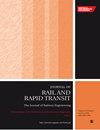高速铁路车辆加速过程车轮磨损预测
IF 2.1
4区 工程技术
Q3 ENGINEERING, CIVIL
Proceedings of the Institution of Mechanical Engineers Part F-Journal of Rail and Rapid Transit
Pub Date : 2023-03-14
DOI:10.1177/09544097231162151
引用次数: 0
摘要
高速铁路车辆加速过程中车轮磨损预测对于改善车站附近运行特性和制定摩擦管理策略具有重要意义,特别是在复杂气候环境下。本文对高速汽车加速过程中车轮磨损的演变进行了分析和预测。首先,建立了高速汽车的详细动力学模型,并采用综合齿轮传动系统捕捉高速汽车的精确动力学响应。其次,根据高斯分布函数设置不同摩擦系数下的模拟轨道间距长度,考虑摩擦系数的影响;针对轮轨接触条件变化带来的挑战,引入了比例积分(PI)蠕变控制器,并基于上述子模型建立了车轮磨损预测模型,得到了车轮磨损演化过程。最后,将车辆动力学模型和车轮磨损预测程序的动态响应仿真结果与现场实测数据进行了比较。结果表明,齿轮传动系统的时变啮合刚度会加剧轮轨相互作用,使车轮磨损恶化。高速机动车在加速过程中经过附着不良区域时,低速期更容易触发蠕变控制器,而高速期则不会发生。本文章由计算机程序翻译,如有差异,请以英文原文为准。
Wheel wear prediction for high speed railway vehicles during acceleration
Wheel wear prediction for high-speed railway vehicles during the acceleration process is of great importance for the improvement of operating characteristics and the development of friction management strategy near the railway station, especially in complex climatic environments. This work analyzes and predicts the wheel wear evolution of high-speed motor cars during acceleration. Firstly, detailed dynamic models of the high-speed motor car are developed, in which a comprehensive gear transmission system is also adopted to capture the accurate dynamic responses of the motor car. Secondly, the length of the simulated track interval with different friction coefficients is set according to the Gaussian distribution function to consider the influence of the friction coefficient. Moreover, a Proportional-Integral(PI) creep controller is also introduced to meet the challenge due to varying wheel-rail contact conditions, and a wheel wear prediction model based on the aforementioned submodels is established to obtain the wheel wear evolution. Finally, simulation results of dynamic responses from the vehicle dynamic model and wheel wear prediction procedure are compared with the measured field data. The results show that the time-varying meshing stiffness from the gear transmission system will aggravate the interaction between wheel and rail and deteriorate the wheel wear. When the high-speed motor car passes through a poor adhesion zone in the acceleration, it is easier to trigger the creep controller at the low-speed period while it will not occur at the high-speed period.
求助全文
通过发布文献求助,成功后即可免费获取论文全文。
去求助
来源期刊

CiteScore
4.80
自引率
10.00%
发文量
91
审稿时长
7 months
期刊介绍:
The Journal of Rail and Rapid Transit is devoted to engineering in its widest interpretation applicable to rail and rapid transit. The Journal aims to promote sharing of technical knowledge, ideas and experience between engineers and researchers working in the railway field.
 求助内容:
求助内容: 应助结果提醒方式:
应助结果提醒方式:


